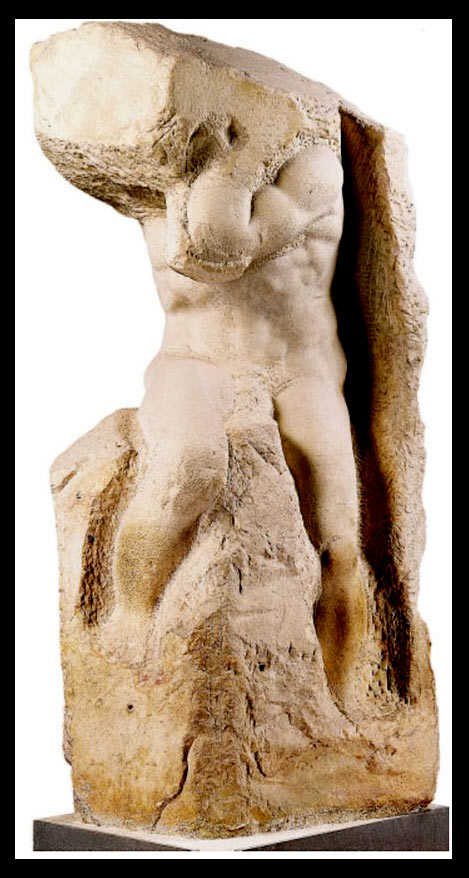The non finito (literally "not finished") style is different, because the artist deliberately leaves parts of the piece uncompleted.
 Michelangelo (left) and Donatello are also notable for their non finito sculptures, where the figure sometimes seems to be contending against its imprisonment in stone.
Michelangelo (left) and Donatello are also notable for their non finito sculptures, where the figure sometimes seems to be contending against its imprisonment in stone.
Online academic essays: Facilità and non finito in Vasari’s Lives. Carlos Montes Serrano
The Process of Artistic Creation in Terms of the Non-finito
GurneyJourney on sprezzatura
 |
| Danäid, 1889, Auguste Rodin (source) |
Rodin's Danaïd, above, is a mythological woman who despairs from her punishment for killing her husband. Her hair merges with the water that she has spilled on the ground, and the curve of her back almost seems like a part of the landscape, merged with the rough marble.
 Michelangelo (left) and Donatello are also notable for their non finito sculptures, where the figure sometimes seems to be contending against its imprisonment in stone.
Michelangelo (left) and Donatello are also notable for their non finito sculptures, where the figure sometimes seems to be contending against its imprisonment in stone.
The non finito style often conveys a particular attitude of the artist toward the piece, suggesting ease, effortlessness, or informality. It has the effect of sprezzatura, which might be translated as studied carelessness.
It can also express a mystical sense of transformation reminiscent Lao Tzu's admonition to "return to the state of the uncarved block."
Studied non-completion is a common device among contemporary realist sculptors and painters, with many academic ateliers exemplifying a style where the rendering is deliberately left unfinished.
The Metropolitan Museum will be hosting an exhibition called Unfinished: Thoughts Left Visible March 18–September 4, 2016 with 197 works at the Met Breuer.
The Process of Artistic Creation in Terms of the Non-finito
GurneyJourney on sprezzatura
Previous posts on unintentionally unfinished works:







7 comments:
I like seeing old unfinished sculptures, as they are mostly valuable to understand the artist's process. Actually not just sculptures, paintings too.
However, I find that contemporary artists who carefully study to leave things unfinished are simply not understanding what non finito is. It's just unfinished, as you James pointed out, because artists lacked enough time to bring it to a proper finish, not because they initially thought they wanted to create an unfinished piece.
If Sprezzatura comes from Sprezzante, then yes, it literally means they "didn't care" about finishing it at all in the end, which is the feeling it necessarily conveys.
Once more, I can hardly describe non finito as a style, but rather as a step, a really useful one to learn from the masters.
"Sprezzatura." Glad to know there is an actual word for that quality.
The post and Fabio's interesting comments prompted me to think about the fact that in some situations the artist and the viewer might differ on the word "finished". It seems like there's an additional category: one in which the artist's "hand" is more visible than in a more polished work, but that wouldn't necessarily mean that the artist didn't take the piece to a desired point of completion. I'm thinking about paintings in particular, and having recently been looking at Leyendecker's roughly cross-hatched backgrounds, it strikes me that some might conceivably see those as unfinished, whereas the style was clearly Leyendecker's intended point of completion. Whether that was "non finito" or "sprezzatura" is debatable, I think, and maybe whether it's either has to be considered in the context of the way Leyendecker generally worked at that particular time. Similarly, when is any loose style (like impressionism) worthy of either term? It's interesting to contemplate, I think.
Tom and Fabio, you both raise interesting points. It's funny that we were thinking about Leyendecker's strokey backgrounds, too, wondering if they qualify. Various styles of painterliness have been accepted as a finished technique for a long time, and when the artist says it's done, it's done.
Maybe the "non-finito" style works best when there's a clear contrast between the finished and unfinished areas, and the finished areas are really highly finished, as with the Rodin. Perhaps as you both suggest we have to factor in the element of the artist's intent. And then that raises the question of whether the intent matters, or whether you can guess the intent from the work itself.
I tend to like the non-finito quality less if it becomes too self-conscious or if it covers for an artist who just doesn't have the skills to ever finish anything, in which case it's not "non-finito," but rather "incapace." Like the old Peanuts cartoon where Lucy asks why Linus he himself didn't draw the hands, and he answers because I myself can't draw hands.
Illustrators like Bernie Fuchs, Mark English, David Grove and Robert Heindel used "Non Finito" quite effectively in a lot of their work. So much of what they said was implied by what was left unfinished or barely indicated.
I Agree with you, James, especially on the last statement! The word incapace actually better fits those artists :D
Post a Comment